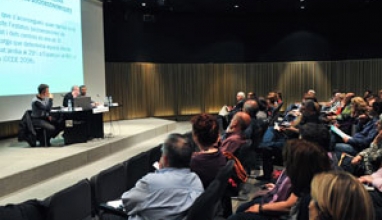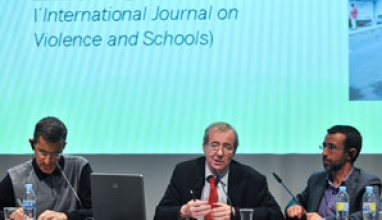You are here
Improving the school environment: why and how?
About the speaker
Éric Debarbieux
Professor at Bordeaux II University and President of the International Observatory on Violence in School
"Teachers and head teachers' work counts and it's important to say so"
Eric Debarbieux analyses the effects of the school environment. Considering the school environment from a broad perspective which includes the organisational model, the teaching relationship in the classroom, the relationship between students and the sense of justice in schools. The school environment affects students, teachers and parents.
Effect of the school environment on performance
• An unfavourable socio-economic environment does not always go hand-in-hand with negative results. The work of educational units (school-class) marks the difference. "Teachers and head teachers work counts and it's important to say so."
• Environment affects performance. Studies show that performance is better if the school environment is one of involvement, encourages students, is one of justice and discipline. By contrast, neither strict discipline nor educational anarchy work well. A cooperative discipline is required which fosters the idea of belonging to the school and recognises the rights of students.
• An efficient school is one that tackles questions such as efficient leadership (a firm and hands-on head teacher), efficient teaching staff (where education is key), emphasis on learning, positive school culture, high expectations in terms of behaviour and results and rights and duties.
The school environment and victimisation
• Violence in schools is not something external which can be resolved with actions outside the school (e.g. police actions). School violence comes from within the school.
• One in every ten students is a victim of bullying.
• Effects of school violence: absenteeism and abandonment (also among good students who are sometimes bullied for being good); mental health problems (higher rates of suicides, depression, loss of self-respect); public safety issues (e.g. a study of bullies over a 40-year period shows that they have higher rates of delinquency, mistreatment, unemployment and being in worst-paid jobs).
• Strong correlation between the school environment and victimisation of school children and adults. A study carried out in difficult schools shows that not all have the same levels of extortion and bullying. The ones with the higher rates were the ones that separated the more difficult students.
• The quality of the teams of adults marks the difference. Students' well-being depends on teachers' well-being. Instability among teaching staff has a negative effect (teachers sent to difficult schools often leave). Regulated stability is called for, together with strong and cooperative leadership and good support for teachers.
How to improve the environment and prevent violence
• Foster reception, co-existence, stability, crisis management, individual plans and tackle stigma. Foster justice in schools. Punishment is sometimes necessary, but this on its own will not solve the problems. Aggressors have the right to change their behaviour. They tend to be conformists and do not know how to change their circumstances. They need to be given the opportunity to see things from other perspectives.
• Tackling the solitude of victims (aggressors and victims alike).
• Don't let time go by. Foster prevention.
• The quality of the system must not be greater than that of its personnel. Education above all.
• Tackle all forms of discrimination and stigmatisation (race, intellectual qualities, disabilities, etc.).
Discover
other ideas
-

The Education of Talent: The Role of Schools and F...
José Antonio Marina
2012 -

Creating innovative environments to improve learni...
David Istance
2012 -

ICTs and the transformation of education in the kn...
Robert B. Kozma
2012





















 The texts published on this website are, unless otherwise indicated, covered by the Creative Commons Spain Attribution - Non Commercial - No Derivs 3.0 licence. You may copy, distribute and transmit the work, provided you attribute it (authorship, journal name, publisher) in the manner specified by the author(s) or licensor(s). You may not use the material for commercial purposes. You may not transmit any derivative work from this material. The full text of the licence can be consulted here:
The texts published on this website are, unless otherwise indicated, covered by the Creative Commons Spain Attribution - Non Commercial - No Derivs 3.0 licence. You may copy, distribute and transmit the work, provided you attribute it (authorship, journal name, publisher) in the manner specified by the author(s) or licensor(s). You may not use the material for commercial purposes. You may not transmit any derivative work from this material. The full text of the licence can be consulted here: